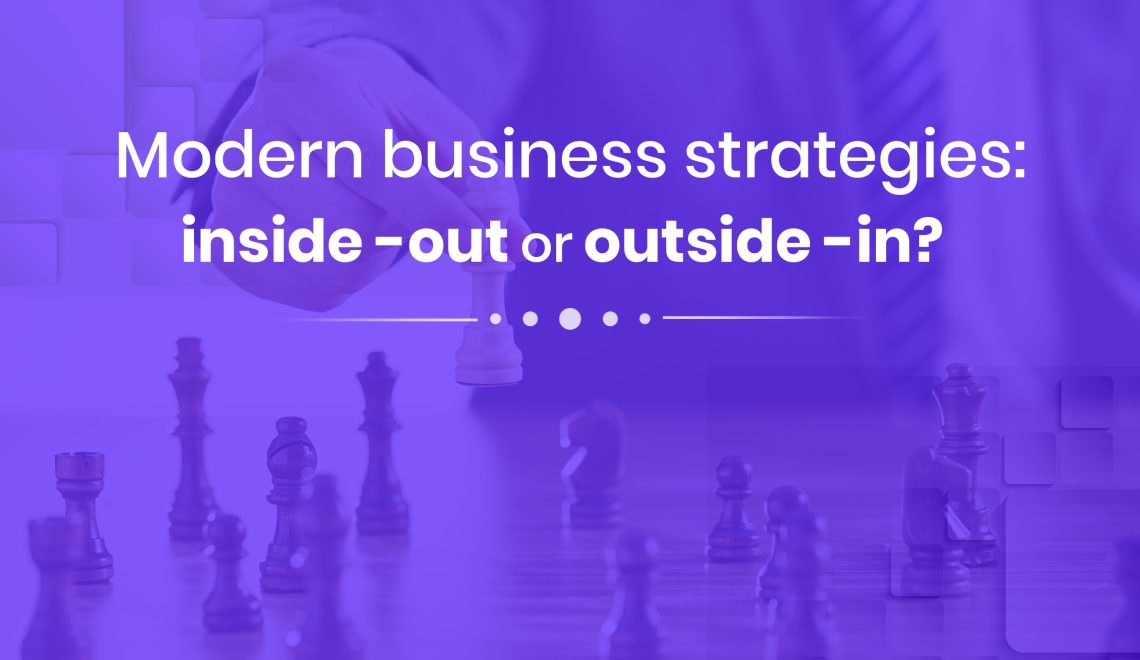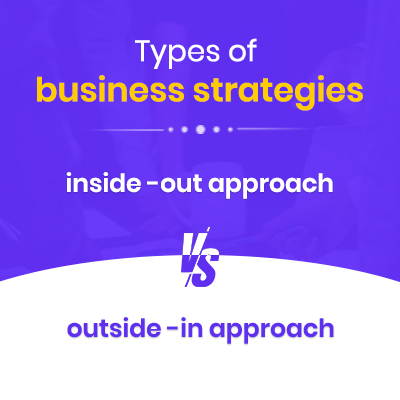
I would like to open a short and insightful discussion on one of my favourite topics in business – the inside-out and outside-in approach. With rapid technological growth, the evolution of eCommerce, and virtual reality, there is constant pressure in the business world to be abreast of the latest technological and digital developments. How does this affect modern business strategies and goals?
Sources of modern business strategies
Businesses need to design effective strategies for the best outcomes. The business strategies have to be developed carefully after considering both external and internal factors. These considerations could include competition, staffing, economic impact, market demand, SWOT analysis, etc. The core elements of business strategy are objective setting, visioning, prioritization, and resource allocation. Based on this the primary sources of business strategies are market evolution, market redefinition, marketing channels, and technological innovation. Further, the business tools used for analyzing modern business strategies include SWOT analysis, PESTEL analysis, Porter’s five force analysis, and value chain analysis. As most business strategies fail due to lack of control and monitoring, effective implementation of the tools can help to ensure the success of business strategies.
Different types of business strategies
Businesses are realigning their strategies, replacing traditional and outdated approaches with novel and innovative thinking patterns and actions. Interconnected markets and the new norm of the global village puts customers in the spotlight. A business strategy is more about how a company positions itself to gain a competitive advantage. The popular modern business strategies are structuralist, growth, cost leadership, price skimming, and acquisition.
A discussion on the inside-out approach and outside-in approach, the two common and widely debated approaches in modern business strategy, seems highly relevant in this context. An inside-out approach develops a product first leveraging the efficient internal process and then moves to create a market for it, while an outside-in approach first understands the market and then creates the product for it. When one approach focuses on the inside capabilities the other focuses on the customers. Let’s elaborate further.

The inside-out approach considers an organization’s inner strengths and capabilities as the key drivers to its success. It is anchored on the concept that strengthening the business process and efficiently utilizing internal resources translates to a successful business.
What you will not find in an inside-out approach are decisions that are customer-centric as the business strategies of a firm are formulated considering the business needs and not the customer needs.
The inside-out strategy improves the back-end efficiency and brings short-term gains. The resources and operations are streamlined to reduce expenditure. Obviously, the profits improve in the short run. Since the focus is on identifying and aligning with the values and beliefs of the company and on leveraging its strengths while eliminating its weaknesses it creates a fundamentally strong foundation for the organization. The approach builds the company value first believing that it ultimately creates customer value.
However, the relevancy of the inside-out approach is questionable in today’s fast-moving business driven by rapidly evolving technology and the emerging global village. With the growth of eCommerce companies now compete for customer attention and stick to the go-to-market approach. I must say that the inside-out approach is a bit outdated in this context. And considering the shift of focus from the customer to the organization, it might even prove detrimental in the long run. Toyota’s experience can be cited in this context. The company shifted from a customer-centric business to an inside-out approach for maximizing growth and out-beating the competition and the consequence was the loss of customers.
The outside-in approach begins with the customer. The business is viewed from the customer’s angle and the strategies and policy decisions are taken in keeping with the customer’s needs. The company is driven by the vision of building lasting relationships with the customers and looks at everything from the customer’s perspective. This approach builds customer value that eventually results in company value.
Outside-in approach is praised for promoting innovativeness. With companies shifting their mindset towards customer needs and competing to provide the best solutions, innovative ideas, and designs hit the market faster. Companies are pushed towards automating their processes, eliminating redundant ones, and increasing their productivity to increase the value to customers. Here, organizations align with consumer psychology with customer satisfaction and customer delight as the buzzword.
The approach is gaining traction and the proponents of outside-in marketing argue that customer satisfaction automatically improves shareholder value. Still, the long-term sustainability of the outside-in approach is being questioned. By shifting the attention to the customers, companies tend to ignore their internal processes, strengths, and weaknesses. Operational inefficiencies could be the result and might eat into the benefits of the outside-in approach.
Recently organizations are showing a total paradigm shift favouring the outside-in approach. Today, marketing efforts revolve around customer needs. However, should we write off the inside-out approach? Not so fast. Consider the success of Apple. The company followed an inside-out approach and focused on strengthening its core message. Again, it is pertinent to note that Apple had an excellent insight into the customer instinct and their strategy can ideally be called a mix of inside-out and outside-in approaches.
Are you inside out or outside in?
You can easily ascertain the approach of your business with a little reflection.
- What are the needs of your targeted customers?
- Do you know the value your products give to your customers?
- Do you listen to your customer’s feedback and try to identify their pain points?
- Do you consider customer feedback in your meetings and design products based on it?
- Does your company make decisions considering the customer’s best interests?
- Do you launch new product lines that sync with the customer’s needs before your competitors?
If your answers to the above questions are negative, you are probably into an inside-out approach, else it is an outside-in approach.
Which one is best for your business?

The question doesn’t have a clear-cut answer. Both approaches have advantages and also drawbacks, but the new age managers show a definite leaning towards the outside-in approach.
From my experience, I personally subscribe to the outside-in approach. Throughout my journey as a business person, I have always listened to the voice of the customer. At my company, we formulate strategies and policies keeping the customer insights gained from in-depth research and designing the products and services around the customer pain points. Here we believe that when you provide value to the customers or when your business identifies and resolves the unique needs of the customers it inevitably leads to profit and long-term success.
I recommend that businesses should make it a priority to listen to their customers and the latest methodologies like ethnographic research should be leveraged to gain valuable insights into customer behaviour and needs.
So, should we make a choice between the inside-out and outside-in approaches, or can we follow a blend incorporating the best of both? What is your take on this?
Follow me on LinkedIn
FAQ
What are the 4 types of business strategies?
The 4 different types of business strategies are differentiation, cost leadership, differentiation, and focused cost leadership.
Why are crafting and executing business strategies important?
It creates a controlled environment for achieving the company’s vision and goals.
How do you craft a strategy?
Focus on business diversification and select a niche product range. Define a strategy based on competitive advantage.
How do you craft a strategy for competitive advantage given an instance?
First, research the target market and identify the potential sources of competitive advantage to define the strategy.
How marketing strategy can be crafted for a business entity?
Sources of business strategies are to develop the marketing goals, outline the right channels and tasks, set the marketing budget, and finalize the marketing strategy.



